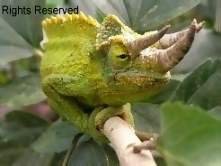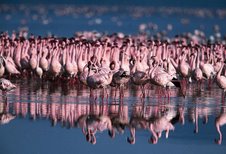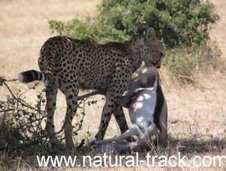Now let's get to this season ……. suppose I ask you a question, "How close have you ever got to a rhino?
In Africa today, the fight for growth of the rhino population is an everyday activity since it was declared an endangered species. Kenya has put up big efforts financially to see to it that rhinos and their habitats have been safe guarded.
It is for this reason that I had to participate in one of the greatest ungulate translocation which took place in Kenya. Kenya Wildlife Service, a body with the mandate of protecting all Kenyan wildlife heritages was spearheading the event. All efforts were geared towards refurbishing of Meru national park and I was glad to be of help in the action.
Due to the intensive tasks involved in translocation, much skills and labor was needed with specific skills required for animal handling.
Rhinos are wonderful animals to look at and even more thrilling when you have an opportunity to get close enough to smell them.
The translocation gave me a great opportunity to observe a rhino at the closest point, touch its hairs on the wrinkled skin, lean on the horn, and see the difference in the mouth shapes and so much more.
Closer look ……
Rhino belongs to the family Rhinoceroteridae with five species placed in four genera. Three of these species are found in south-central Asia and the other two live in Africa south of the Sahara. It is in this region you'll find Kenya, where rhinos inhabit savannahs, shrubby regions and occasionally the dense forests.
Rhino's problem has been its beauty, the horn which is made of keratin (a substance found in human hair and nails). Powdered Rhino horn has been used extensively in traditional medicine in Asia and to make ornamental dagger handles by the Yemen men. The demand is so great that traders are prepared to pay poachers vast sums to kill rhinos for their horns. Because of these, Rhinos have faced wholesale slaughter which led to their unimaginable decline and sweep off in Meru national park in 70's.
To stop these abuse, governments and bodies such as Save the Rhino teamed up together to halt the abusive. Thanks to them, the overall decline of the rhino has been halted, and populations in Africa are beginning to stabilize.
Interesting…….
Now that I hold a 'legacy' of moving rhinos, allow me to quickly share something interesting about African rhino species.
As mentioned earlier, we have two rhino species in Africa namely the black and white rhinos. These two African species live in more open areas than do the Asian species. Their habitat has to generally have access to water, as they usually drink everyday. The white rhinos have a preference of feeding low to the open grounds whereas the black rhino usually browse on leaves and have a tendency to stay hidden. They have been noted to be more active in the evening, through the night and in early morning, spending their days resting in heavy cover.
In general……
The history of the rhino can be traced back to 45 million years ago. The Baluchitherium, an ancestor of the Indian rhino, was the largest land mammal that ever lived. It was 18 feet high and 36 feet long and lived over 20 million years ago.
Rhinos sleep in both standing and laying positions and love to wallow in muddy pools and sandy riverbeds. They penetrate dense thickets by shear force, often leaving behind a trail that other animal's later use. Rhinos run with a cumbersome motion, reaching top speed at a canter. They can, however, attain speeds of up to 45 km per hour for short distances. Basically the black rhino is more solitary and territorial except for the mother-child unit.
 |
| White Rhino in Kenya Safari Holiday |
Breeding……
Female rhinos give birth every 2 years to a single calf, which is active soon after birth and the calf remains with the mother until the next offspring is born. Gestation period is 420-570 days while sexual maturity is reached at 7-10 years for bulls and 4-6 years for cows.They have a life span of up to 50 years.
Groups of adult cows or bachelor bulls are sometimes formed, however, and during the mating season pairs of rhinos may stay together for up to 4 months. Rhinos mark their territories with urine and by dropping their dung in well-defined piles that can reach up to 1 m in height. They often furrow the areas around these piles with their horns and make the piles even more conspicuous.
The black rhino has a wide vocal range and can possibly communicate like an elephant,
through frequencies below the range of human hearing. Breathing is an important part of communication. Unlike the white rhino-calf, the black rhino calf normally runs behind its mother.
Current standing & population
There were an estimated 20,000 black rhino in Kenya in the 1970s. By 1982 the population was reduced to fewer than 400. Since then, their number has increased and now stands at over 450. The number in fenced areas has risen at an average rate of four percent each year when the conditions are good. Since 1984 the Kenyan government has pursued an active program devoted to the recovery of Kenya’s black rhino, with efforts centering on the development of specially protected or fenced sanctuaries on government and private land, such as Lewa.
Rhino populations under custodianship both on private land (Solio Ranch) and in some
State-run areas (such as Nairobi and Nakuru National Park) have provided set up for new populations (including reintroducing animals into an electrified-fence sanctuary inside the KWS-run Tsavo West and Meru National Parks). The private sector thus plays an important part in the conservation of rhino in Kenya and currently supplies many of the animals being used to restock state parks.
Kenya is currently the stronghold of the Eastern African subspecies Diceros bicornis michaeli, a home to about 88 % of the population in 1995. Like South Africa and Namibia, Kenya is doing trans location to set up new populations while aiming to ensure that donor populations
remain productive. The public plight of the black rhino has attracted support from many different areas.
Today, scientists are formulating a method of «fingerprinting» rhino horn based on the nutrient content of each specific rhino conservation area. This will enable them to pinpoint the area a rhino came from, its family group, and even its preferred diet. It is also an important step toward eradicating poaching, as scientists will be able to determine where a rhino was when it was killed.
Today we stop here …… until next issue
Adios amigo..
Adventure travel crew
Kenia Safary
Natural Track








